Eco-Friendly, High-Ductility Slag/Fly-Ash-Based Engineered Cementitious Composite (ECC) Reinforced with PE Fibers
Abstract
:1. Introduction
2. Materials and Methods
2.1. Raw Materials and Mix Proportion
2.2. Specimen Preparation
2.3. Compressive Strength
2.4. Tensile Strength
2.5. Flexural Bending Test
2.6. Microstructure and Mineralogical Characterization
3. Results and Discussion
3.1. Compressive Strength
3.2. Tensile Strength
3.3. Flexural Bending Strength
3.4. Crack Characteristics of Loaded ECC
3.5. Mineralogical and Microstructural Characterization
3.5.1. SEM and EDS
3.5.2. XRD and XRF Analysis
4. Conclusions
Author Contributions
Funding
Institutional Review Board Statement
Informed Consent Statement
Data Availability Statement
Conflicts of Interest
References
- Li, V.C. Introduction to Engineered Cementitious Composites (ECC). In Engineered Cementitious Composites (ECC); Springer: Berlin/Heidelberg, Germany, 2019; pp. 1–10. ISBN 978-3-662-58437-8. [Google Scholar]
- Wu, H.-L.; Zhang, D.; Du, Y.-J.; Li, V.C. Durability of Engineered Cementitious Composite Exposed to Acid Mine Drainage. Cem. Concr. Compos. 2020, 108, 103550. [Google Scholar] [CrossRef]
- Huang, B.-T.; Yu, J.; Wu, J.-Q.; Dai, J.-G.; Leung, C.K.Y. Seawater Sea-Sand Engineered Cementitious Composites (SS-ECC) for Marine and Coastal Applications. Compos. Commun. 2020, 20, 100353. [Google Scholar] [CrossRef]
- Sun, R.; Hu, X.; Ling, Y.; Zuo, Z.; Zhuang, P.; Wang, F. Chloride Diffusion Behavior of Engineered Cementitious Composite under Dry-Wet Cycles. Constr. Build. Mater. 2020, 260, 119943. [Google Scholar] [CrossRef]
- Herbert, E.; Li, V. Self-Healing of Microcracks in Engineered Cementitious Composites (ECC) Under a Natural Environment. Materials 2013, 6, 2831–2845. [Google Scholar] [CrossRef]
- Zhang, P.; Yang, Y.; Wang, J.; Jiao, M.; Ling, Y. Fracture Models and Effect of Fibers on Fracture Properties of Cementitious Composites—A Review. Materials 2020, 13, 5495. [Google Scholar] [CrossRef]
- Lan, M.; Zhou, J.; Xu, M. Effect of Fibre Types on the Tensile Behaviour of Engineered Cementitious Composites. Front. Mater. 2021, 8, 775188. [Google Scholar] [CrossRef]
- Al-Fakih, A.; Mohammed, B.S.; Liew, M.S. On Rubberized Engineered Cementitious Composites (R-ECC): A Review of the Constituent Material. Case Stud. Constr. Mater. 2021, 14, e00536. [Google Scholar] [CrossRef]
- Huang, B.-T.; Zhu, J.-X.; Weng, K.-F.; Huang, J.-Q.; Dai, J.-G. Prefabricated UHPC-Concrete-ECC Underground Utility Tunnel Reinforced by Perforated Steel Plate: Experimental and Numerical Investigations. Case Stud. Constr. Mater. 2022, 16, e00856. [Google Scholar] [CrossRef]
- Veigas, M.G.; Najimi, M.; Shafei, B. Cementitious Composites Made with Natural Fibers: Investigation of Uncoated and Coated Sisal Fibers. Case Stud. Constr. Mater. 2022, 16, e00788. [Google Scholar] [CrossRef]
- Zhu, Y.; Yang, Y.; Yao, Y. Use of Slag to Improve Mechanical Properties of Engineered Cementitious Composites (ECCs) with High Volumes of Fly Ash. Constr. Build. Mater. 2012, 36, 1076–1081. [Google Scholar] [CrossRef]
- Lim, I.; Chern, J.-C.; Liu, T.; Chan, Y.-W. Effect of Ground Granulated Blast Furnace Slag on Mechanical Behavior of Pva-Ecc. J. Mar. Sci. Technol. 2012, 20, 11. [Google Scholar] [CrossRef]
- Singh, S.; Khairandish, M.I.; Razahi, M.M.; Kumar, R.; Chohan, J.S.; Tiwary, A.; Sharma, S.; Li, C.; Ilyas, R.A.; Asyraf, M.R.M.; et al. Preference Index of Sustainable Natural Fibers in Stone Matrix Asphalt Mixture Using Waste Marble. Materials 2022, 15, 2729. [Google Scholar] [CrossRef] [PubMed]
- Li, W.; Shumuye, E.D.; Shiying, T.; Wang, Z.; Zerfu, K. Eco-Friendly Fibre Reinforced Geopolymer Concrete: A Critical Review on the Microstructure and Long-Term Durability Properties. Case Stud. Constr. Mater. 2022, 16, e00894. [Google Scholar] [CrossRef]
- Rajawat, A.S.; Singh, S.; Gangil, B.; Ranakoti, L.; Sharma, S.; Asyraf, M.R.M.; Razman, M.R. Effect of Marble Dust on the Mechanical, Morphological, and Wear Performance of Basalt Fibre-Reinforced Epoxy Composites for Structural Applications. Polymers 2022, 14, 1325. [Google Scholar] [CrossRef]
- Ling, Y.; Wang, K.; Li, W.; Shi, G.; Lu, P. Effect of Slag on the Mechanical Properties and Bond Strength of Fly Ash-Based Engineered Geopolymer Composites. Compos. Part B Eng. 2019, 164, 747–757. [Google Scholar] [CrossRef]
- Booya, E.; Adesina, A.; Gorospe, K.; Das, S. The Performance of Slag Containing Engineered Cementitious Composites. IOP Conf. Ser. Mater. Sci. Eng. 2020, 978, 012024. [Google Scholar] [CrossRef]
- Zhang, Z.; Liu, S.; Yang, F.; Weng, Y.; Qian, S. Sustainable High Strength, High Ductility Engineered Cementitious Composites (ECC) with Substitution of Cement by Rice Husk Ash. J. Clean. Prod. 2021, 317, 128379. [Google Scholar] [CrossRef]
- Zhang, Z.; Yang, F.; Liu, J.-C.; Wang, S. Eco-Friendly High Strength, High Ductility Engineered Cementitious Composites (ECC) with Substitution of Fly Ash by Rice Husk Ash. Cem. Concr. Res. 2020, 137, 106200. [Google Scholar] [CrossRef]
- Dhandapani, Y.; Santhanam, M. Assessment of Pore Structure Evolution in the Limestone Calcined Clay Cementitious System and Its Implications for Performance. Cem. Concr. Compos. 2017, 84, 36–47. [Google Scholar] [CrossRef]
- Dhandapani, Y.; Sakthivel, T.; Santhanam, M.; Gettu, R.; Pillai, R.G. Mechanical Properties and Durability Performance of Concretes with Limestone Calcined Clay Cement (LC3). Cem. Concr. Res. 2018, 107, 136–151. [Google Scholar] [CrossRef]
- ACI Committee. Fly Ash, Slag, Silica Fume, and Natural Pozzolans in Concrete; ACI: Farmington Hills, MI, USA, 1989; pp. 54–72. [Google Scholar]
- Yuksel, I. Blast-Furnace Slag. In Waste and Supplementary Cementitious Materials in Concrete; Elsevier: Amsterdam, The Netherlands, 2018; pp. 361–415. ISBN 978-0-08-102156-9. [Google Scholar]
- Vagelis, G.P.; Michael, N.F.; Costas, G.V. Hydration and Carboonation of Pozzolanic Cements. ACI Mater. J. 1992, 89, 119–130. [Google Scholar]
- Marangu, J.M.; Thiong’o, J.K.; Wachira, J.M. Review of Carbonation Resistance in Hydrated Cement Based Materials. J. Chem. 2019, 2019, 1–6. [Google Scholar] [CrossRef]
- Lerch, W.; Bogue, R.H. Heat of Hydration of Portland Cement Pastes. Bur. Stand. J. Res. 1934, 12, 645. [Google Scholar] [CrossRef]
- Ahmed, A. Chemical Reactions in Pozzolanic Concrete. Mod. Approaches Mater. Sci. 2019, 1, 125–137. [Google Scholar] [CrossRef]
- Nevile, A.M. Properties of Concrete, 3rd ed.; Longman: London, UK, 1994; ISBN 0-470-20552-0. [Google Scholar]
- Taylor, H.F.W. Cement Chemistry, 2nd ed.; T. Telford: London, UK, 1997; ISBN 978-0-7277-2592-9. [Google Scholar]
- Martirena Hernández, J.F.; Middendorf, B.; Gehrke, M.; Budelmann, H. Use of Wastes of the Sugar Industry as Pozzolana in Lime-Pozzolana Binders: Study of the Reaction. Cem. Concr. Res. 1998, 28, 1525–1536. [Google Scholar] [CrossRef]
- Abdullah, A.; Jaafar, M.S.; Taufiq-Yap, Y.H.; Alhozaimy, A.; Al-Negheimish, A.; Noorzaei, J. The Effect of Various Chemical Activators on Pozzolanic Reactivity: A Review. Sci. Res. Essays 2012, 7. [Google Scholar] [CrossRef]
- Booya, E.; Gorospe, K.; Das, S.; Loh, P. The Influence of Utilizing Slag in Lieu of Fly Ash on the Performance of Engineered Cementitious Composites. Constr. Build. Mater. 2020, 256, 119–412. [Google Scholar] [CrossRef]
- O’Meara, S. China’s Plan to Cut Coal and Boost Green Growth. Nature 2020, 584, S1–S3. [Google Scholar] [CrossRef]
- Chen, Y.; Gao, J.; Tang, L.; Li, X. Resistance of Concrete against Combined Attack of Chloride and Sulfate under Drying–Wetting Cycles. Constr. Build. Mater. 2016, 106, 650–658. [Google Scholar] [CrossRef]
- Liu, H.; Zhang, Q.; Li, V.; Su, H.; Gu, C. Durability Study on Engineered Cementitious Composites (ECC) under Sulfate and Chloride Environment. Constr. Build. Mater. 2017, 133, 171–181. [Google Scholar] [CrossRef]
- Sabapathy, L.; Mohammed, B.S.; Al-Fakih, A.; Wahab, M.M.A.; Liew, M.S.; Amran, Y.H.M. Acid and Sulphate Attacks on a Rubberized Engineered Cementitious Composite Containing Graphene Oxide. Materials 2020, 13, 3125. [Google Scholar] [CrossRef] [PubMed]
- Shoji, D.; He, Z.; Zhang, D.; Li, V.C. The Greening of Engineered Cementitious Composites (ECC): A Review. Constr. Build. Mater. 2022, 327, 126701. [Google Scholar] [CrossRef]
- Wu, H.; Yu, J.; Du, Y.; Li, V.C. Mechanical Performance of MgO-Doped Engineered Cementitious Composites (ECC). Cem. Concr. Compos. 2021, 115, 103857. [Google Scholar] [CrossRef]
- Choi, W.-C.; Yun, H.-D.; Kang, J.-W.; Kim, S.-W. Development of Recycled Strain-Hardening Cement-Based Composite (SHCC) for Sustainable Infrastructures. Compos. Part B Eng. 2012, 43, 627–635. [Google Scholar] [CrossRef]
- Zhu, Y.; Zhang, Z.; Yang, Y.; Yao, Y. Measurement and Correlation of Ductility and Compressive Strength for Engineered Cementitious Composites (ECC) Produced by Binary and Ternary Systems of Binder Materials: Fly Ash, Slag, Silica Fume and Cement. Constr. Build. Mater. 2014, 68, 192–198. [Google Scholar] [CrossRef]
- Felekoglu, B.; Tosun-Felekoglu, K.; Ranade, R.; Zhang, Q.; Li, V.C. Influence of Matrix Flowability, Fiber Mixing Procedure, and Curing Conditions on the Mechanical Performance of HTPP-ECC. Compos. Part B Eng. 2014, 60, 359–370. [Google Scholar] [CrossRef]
- Ministry of Construction of the People’s Republic of China Standard for Test Method of Mechanical Properties on Ordinary Concrete (GB/T 50081-2002) 2003. Available online: https://www.gb-gbt.cn/PDF.aspx/GBT50081-2002 (accessed on 1 April 2022).
- Zhao, J.; Wang, K.; Wang, S.; Wang, Z.; Yang, Z.; Shumuye, E.D.; Gong, X. Effect of Elevated Temperature on Mechanical Properties of High-Volume Fly Ash-Based Geopolymer Concrete, Mortar and Paste Cured at Room Temperature. Polymers 2021, 13, 1473. [Google Scholar] [CrossRef]
- Razavi, S.M.; Nazarpour, H.; Hosseinali Beygi, M. Evaluation of Mechanical and Microstructure Properties of Engineered Cementitious Composites Made of Zeolite. Struct. Concr. 2021, 22, 2736–2747. [Google Scholar] [CrossRef]
- Md Zain, M.R.; Oh, C.L.; Wee, L.S. Performance of Eco Engineered Cementitious Composites Containing Supplementary Cementitious Materials as a Binder and Recycled Concrete Fines as Fine Aggregate. IOP Conf. Ser. Mater. Sci. Eng. 2021, 1200, 012004. [Google Scholar] [CrossRef]
- Tahmouresi, B.; Nemati, P.; Asadi, M.A.; Saradar, A.; Mohtasham Moein, M. Mechanical Strength and Microstructure of Engineered Cementitious Composites: A New Configuration for Direct Tensile Strength, Experimental and Numerical Analysis. Constr. Build. Mater. 2021, 269, 121361. [Google Scholar] [CrossRef]
- Altwair, N.M.; Megat Johari, M.A.; Saiyid Hashim, S.F. Flexural Performance of Green Engineered Cementitious Composites Containing High Volume of Palm Oil Fuel Ash. Constr. Build. Mater. 2012, 37, 518–525. [Google Scholar] [CrossRef]
- Xu, L.-Y.; Huang, B.-T.; Dai, J.-G. Development of Engineered Cementitious Composites (ECC) Using Artificial Fine Aggregates. Constr. Build. Mater. 2021, 305, 124742. [Google Scholar] [CrossRef]
- Yang, H.; Che, Y.; Leng, F. Calcium Leaching Behavior of Cementitious Materials in Hydrochloric Acid Solution. Sci. Rep. 2018, 8, 8806. [Google Scholar] [CrossRef] [PubMed]
- Pesce, C.; Pesce, G.L.; Molinari, M.; Richardson, A. Effects of Organic Additives on Calcium Hydroxide Crystallisation during Lime Slaking. Cem. Concr. Res. 2021, 139, 106254. [Google Scholar] [CrossRef]
- Scnrvexen, K. The Microstructureof Concrete. Mater. Sci. Concr. 2000, 18, 127–157. [Google Scholar]
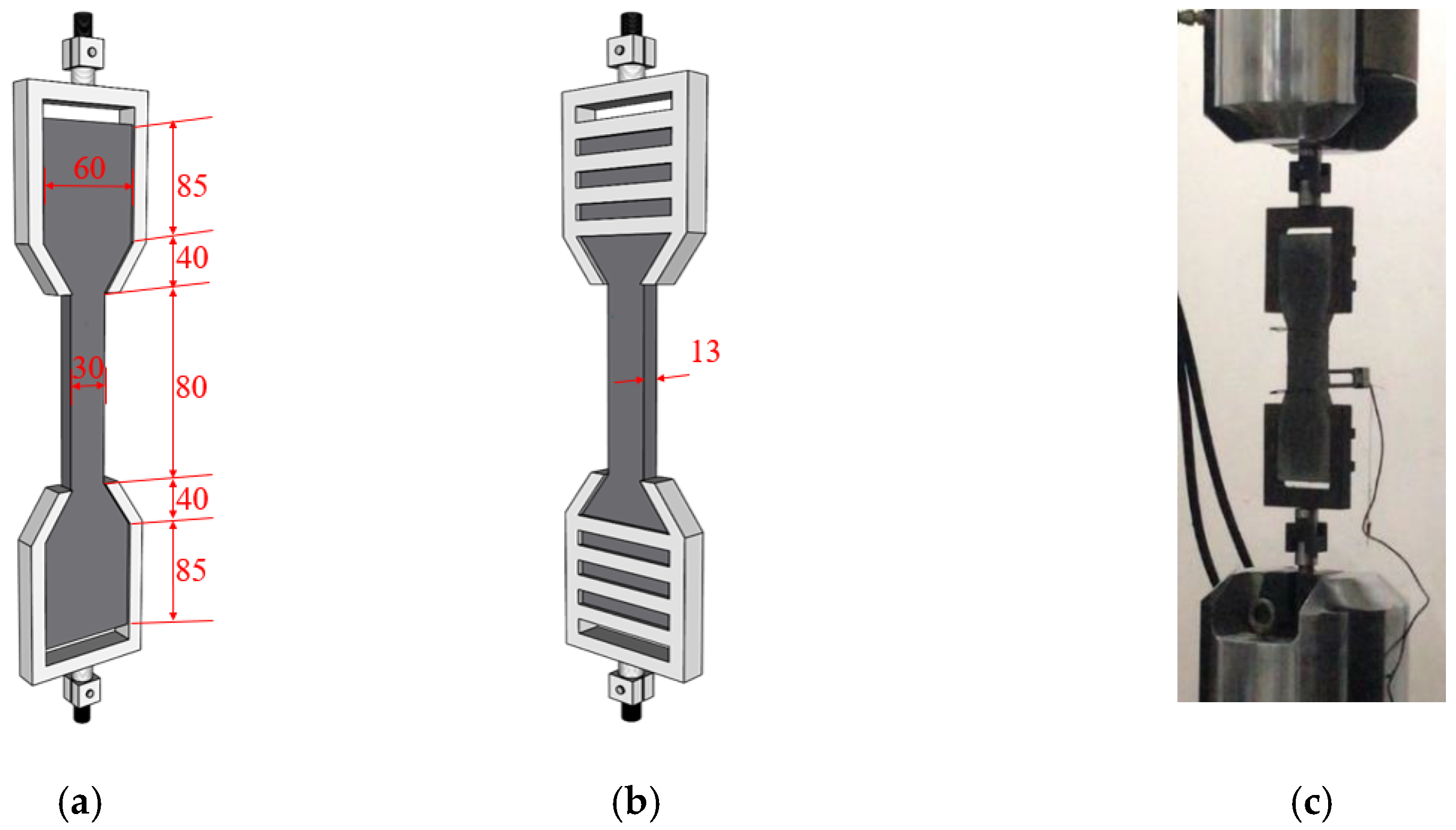


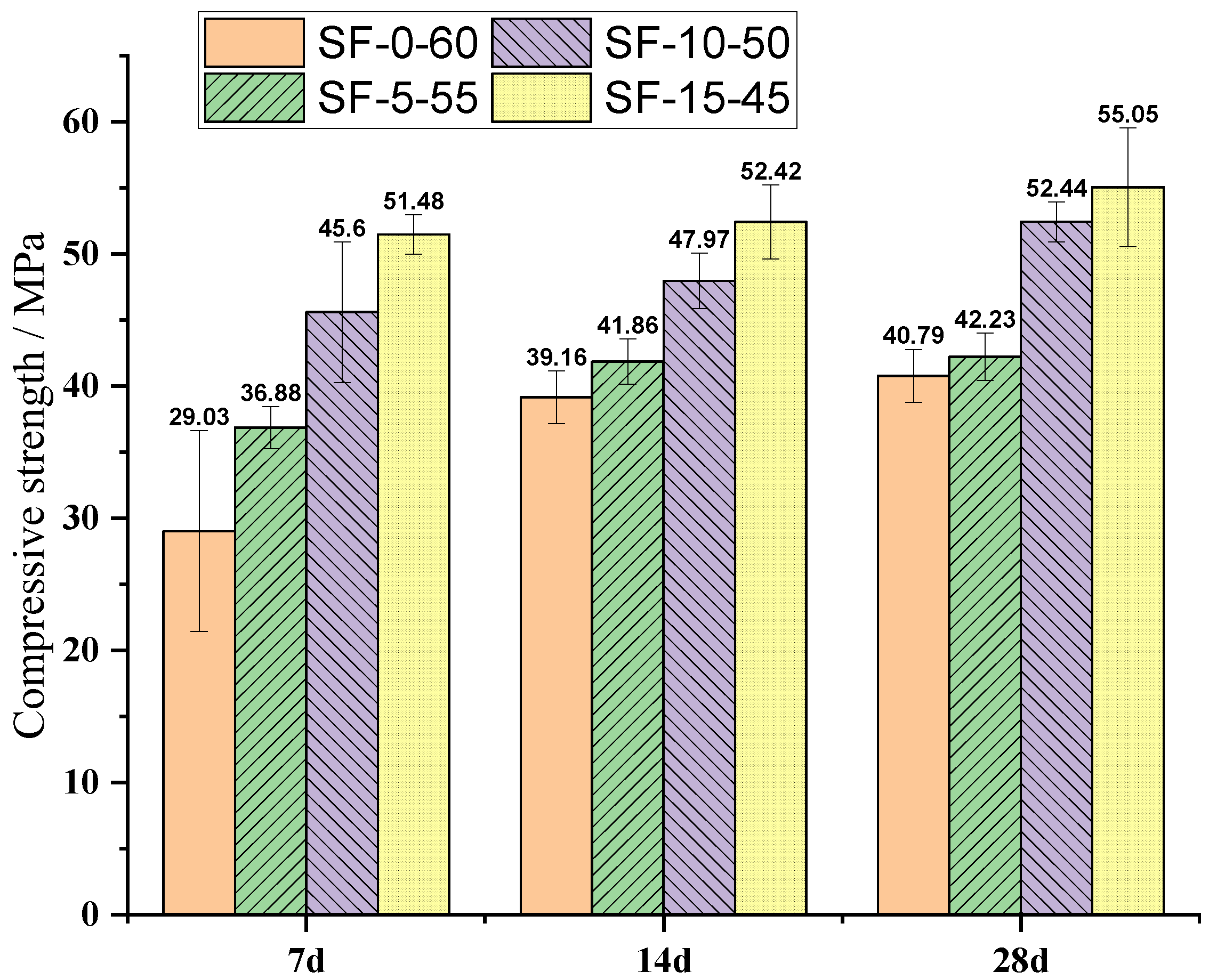

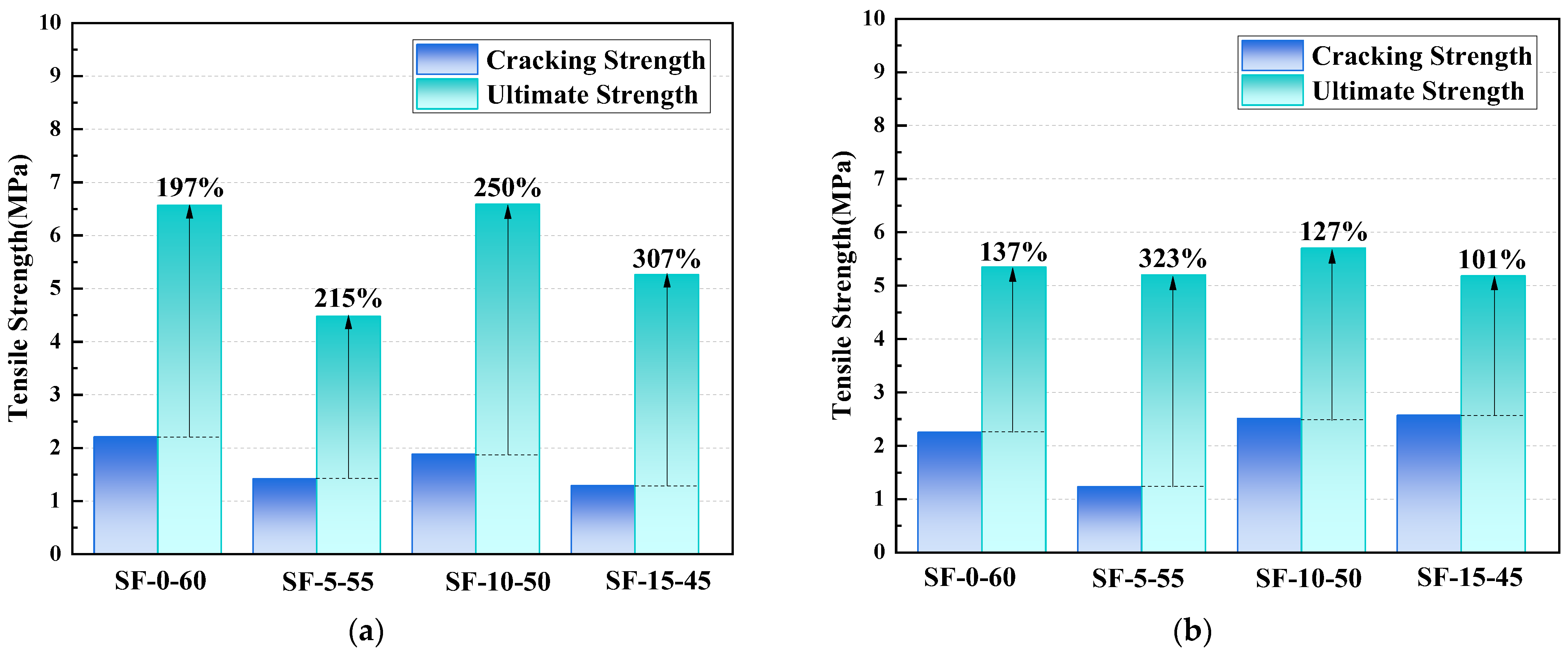
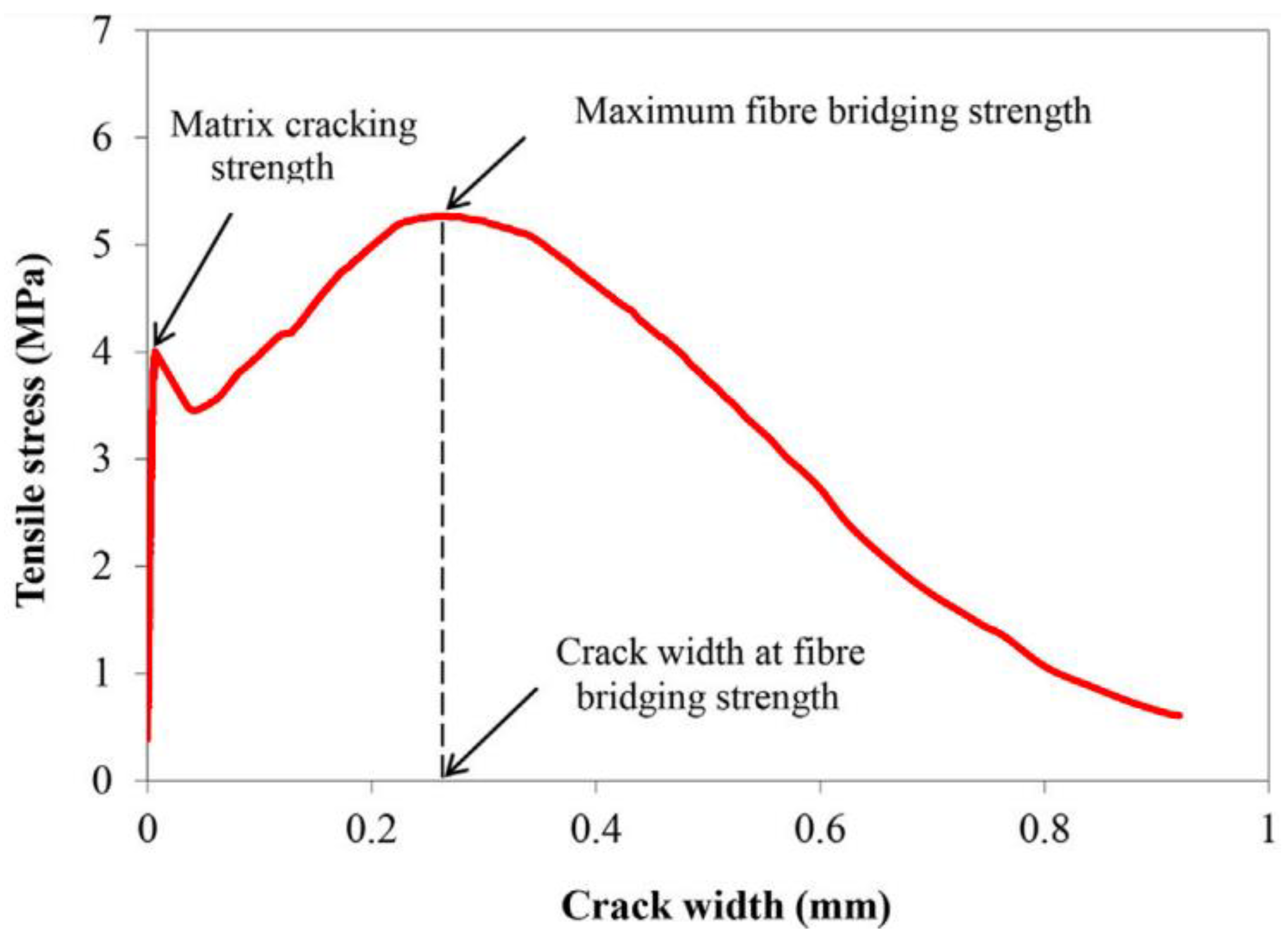

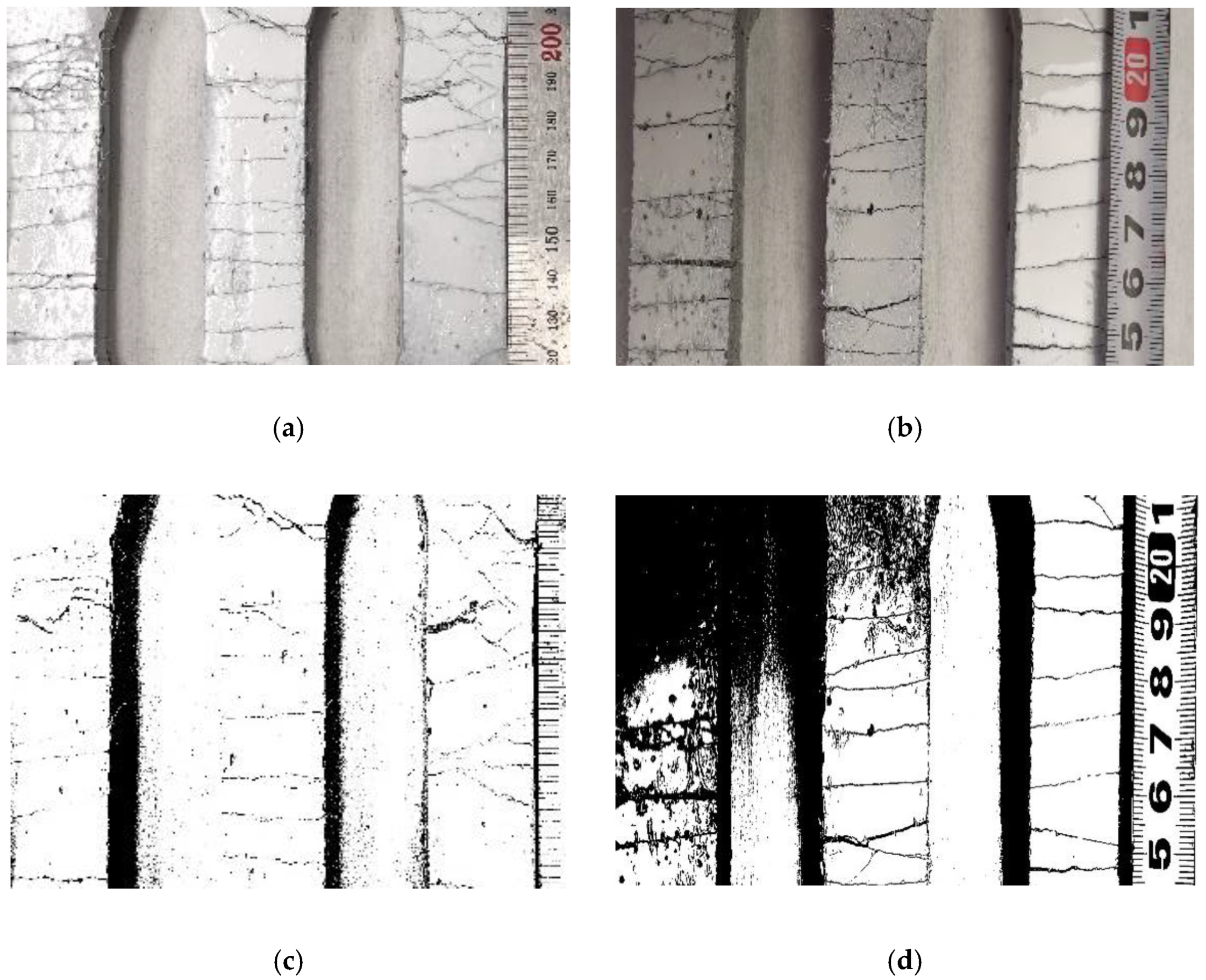

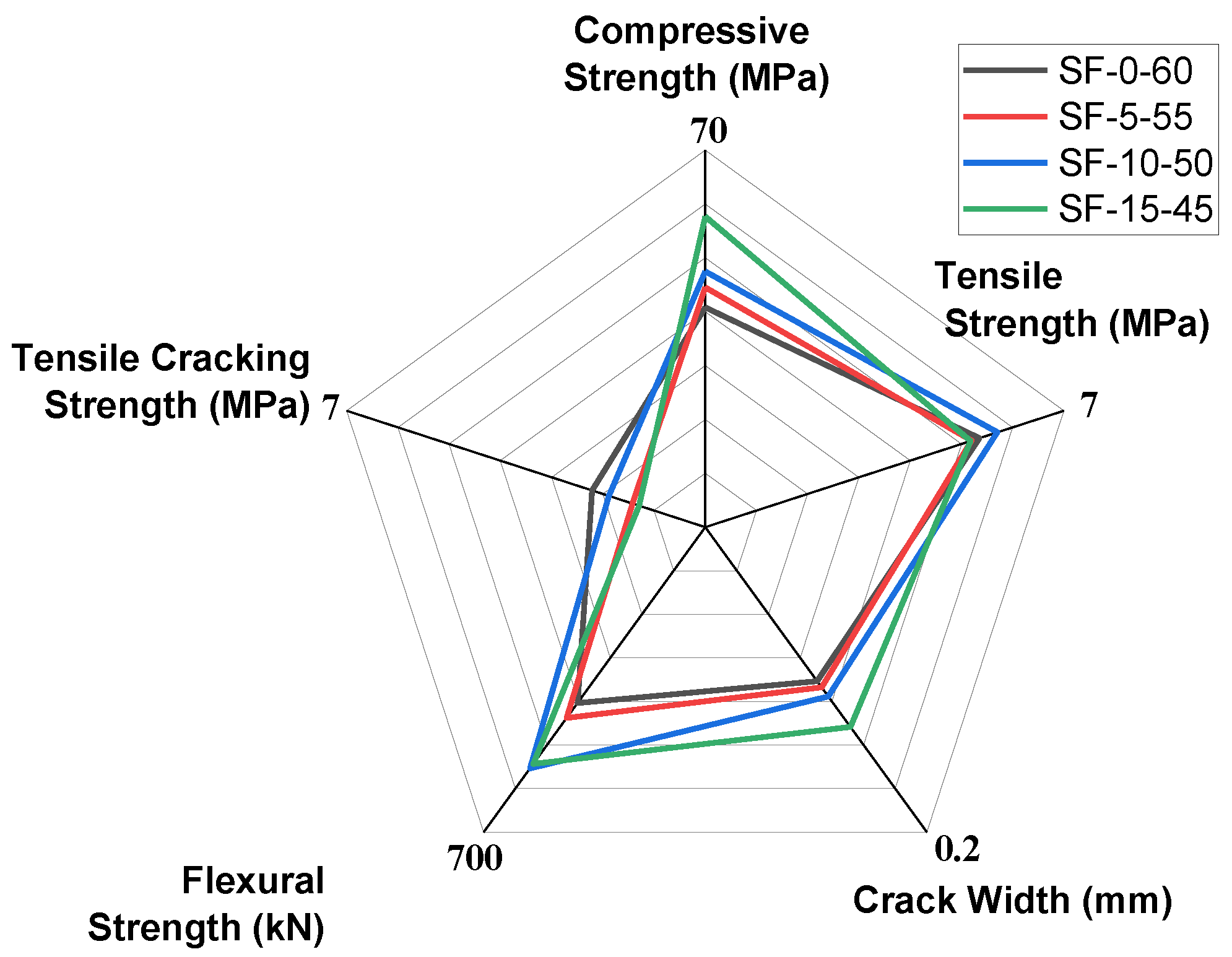
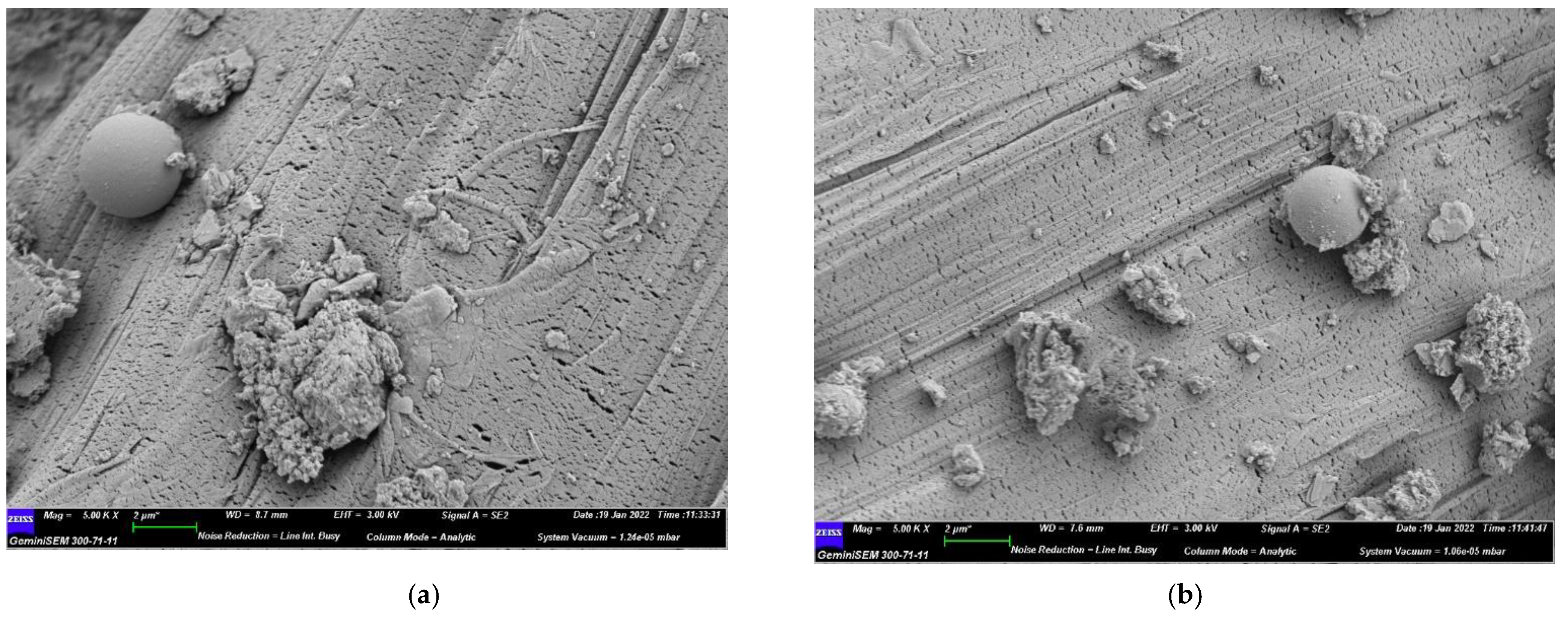
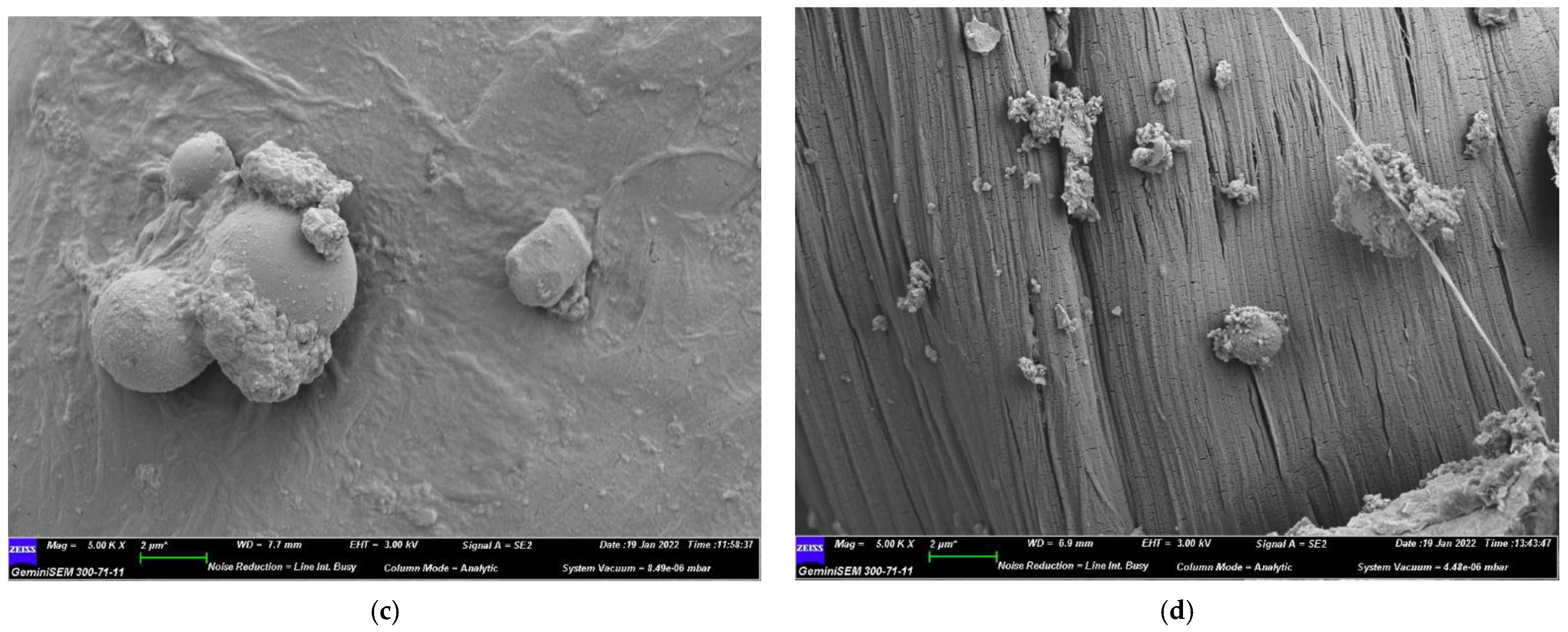
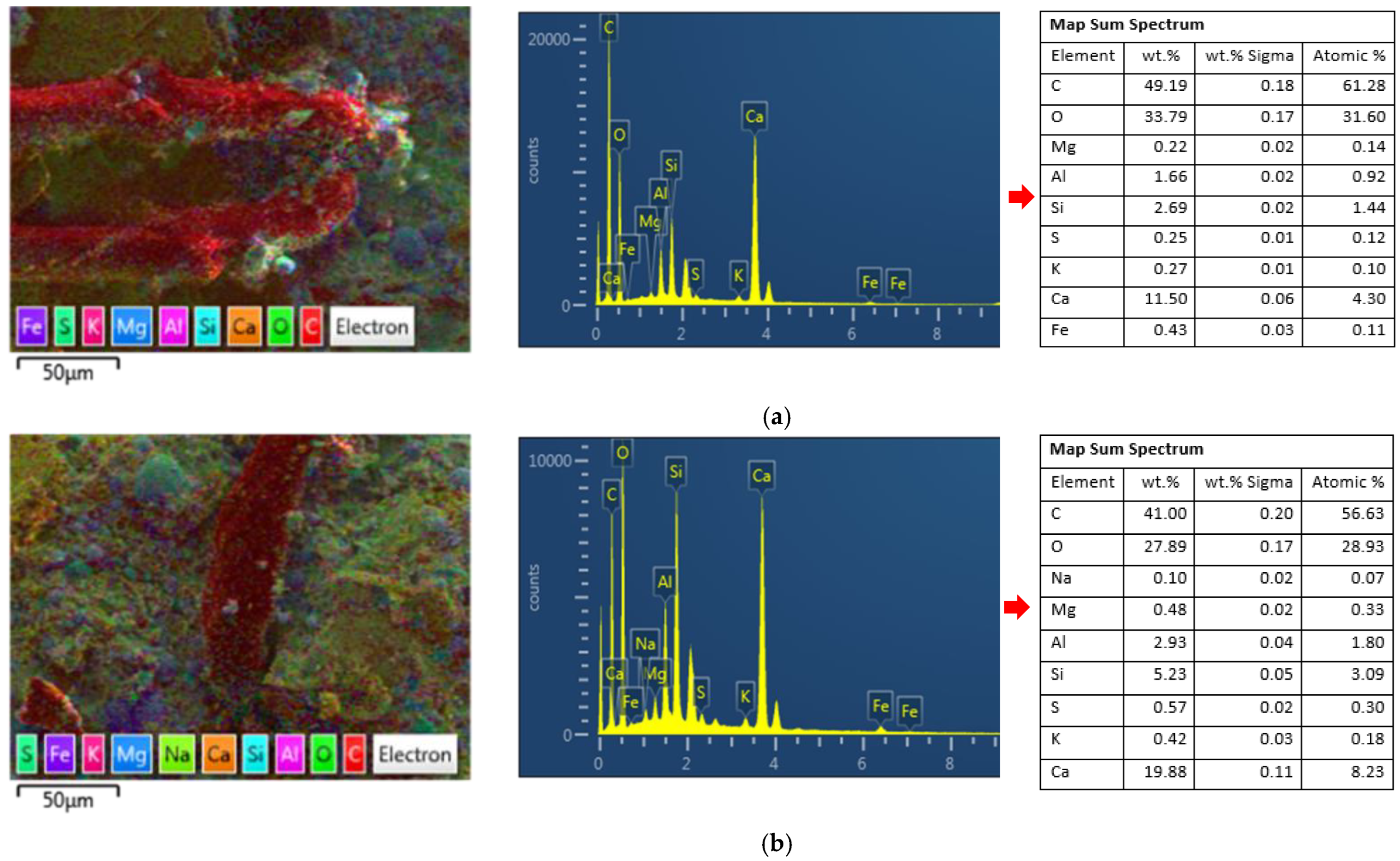

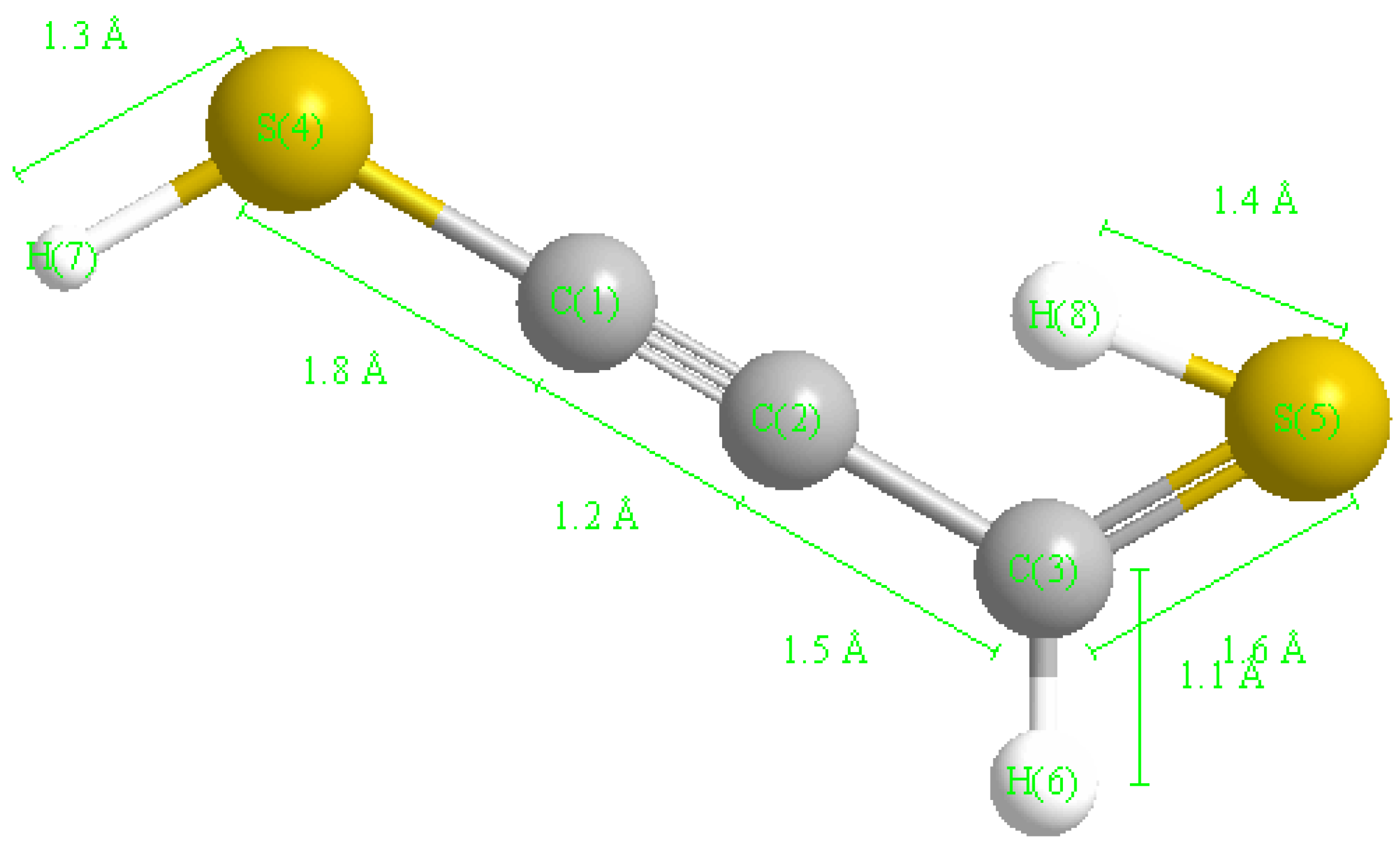

| Mix ID | Slag | FA | Cement | Water | Sand | PE | HRWR |
|---|---|---|---|---|---|---|---|
| SF-0-60 | 0.00 | 799.90 | 533.30 | 400 | 266.60 | 15 | 4 |
| SF-5-55 | 66.60 | 733.20 | 533.30 | 400 | 266.60 | 15 | 4 |
| SF-10-50 | 133.30 | 666.60 | 533.30 | 400 | 266.60 | 15 | 4 |
| SF-15-45 | 199.90 | 599.90 | 533.30 | 400 | 266.60 | 15 | 4 |
| SiO2 | Al2O3 | Fe2O3 | SO3 | CaO | MgO | Na2O | K2O | Others | LOI 1 | |
|---|---|---|---|---|---|---|---|---|---|---|
| Fly ash (FA) | 45.20 | 26.10 | 6.93 | 1.38 | 11.84 | 1.28 | 1.73 | 1.54 | 6.64 | 4.32 |
| Slag (SL) | 36.50 | 14.30 | 3.20 | 2.21 | 33.60 | 7.50 | 0.38 | 0.34 | 0.80 | 0.46 |
| Cement (C) | 17.94 | 4.46 | 3.56 | 3.19 | 64.56 | 3.75 | 0.17 | 1.17 | 0.30 | 3.01 |
| Name | Fiber Length (mm) | Diameter (µm) | Young’s Modulus (GPa) | Elongation (%) | Tensile Strength (MPa) | Density (g/cm3) |
|---|---|---|---|---|---|---|
| PE | 18 | 20 | 100 | 3 | 3000 | 0.97 |
| Specimen Designation | First-Crack Tensile Strength (MPa) | Ultimate Tensile Strength (MPa) | Ultimate Flexural Load (kN) | |||
|---|---|---|---|---|---|---|
| 7 Days | 28 Days | 7 Days | 28 Days | 7 Days | 28 Days | |
| SF-0-60 | 2.21 | 2.25 | 6.57 | 5.35 | 445.70 | 403.48 |
| SF-5-55 | 1.42 | 1.23 | 4.48 | 5.20 | 411.30 | 438.00 |
| SF-10-50 | 1.88 | 2.51 | 6.59 | 5.70 | 531.90 | 553.48 |
| SF-15-45 | 1.29 | 2.57 | 5.26 | 5.18 | 561.50 | 543.12 |
| Compound (c) | Element (E) | (c) wt.% | (E) wt.% | (c) (wt.%) | (E) (wt.%) | (c) (wt.%) | (E) (wt.%) | (c) (wt.%) | (E) (wt.%) |
|---|---|---|---|---|---|---|---|---|---|
| SF-0-60 | SF-5-55 | SF-10-50 | SF-15-45 | ||||||
| CaO | Ca | 40.04 | 28.63 | 36.80 | 26.31 | 39.68 | 28.37 | 40.23 | 28.77 |
| SiO2 | Si | 32.90 | 15.38 | 34.50 | 16.13 | 32.77 | 15.32 | 33.20 | 15.52 |
| Al2O3 | Al | 16.79 | 8.89 | 18.08 | 9.57 | 16.90 | 8.94 | 16.10 | 8.52 |
| Fe2O3 | Fe | 4.23 | 2.96 | 4.21 | 2.94 | 3.89 | 2.72 | 3.76 | 2.63 |
| MgO | Mg | 1.75 | 1.06 | 2.01 | 1.21 | 2.33 | 1.41 | 2.51 | 1.51 |
| SO3 | Sx | 1.72 | 0.688 | 1.67 | 0.668 | 1.66 | 0.666 | 1.61 | 0.645 |
| K2O | K | 1.06 | 0.876 | 1.20 | 0.993 | 1.14 | 0.944 | 1.09 | 0.903 |
Publisher’s Note: MDPI stays neutral with regard to jurisdictional claims in published maps and institutional affiliations. |
© 2022 by the authors. Licensee MDPI, Basel, Switzerland. This article is an open access article distributed under the terms and conditions of the Creative Commons Attribution (CC BY) license (https://creativecommons.org/licenses/by/4.0/).
Share and Cite
Shumuye, E.D.; Liu, J.; Li, W.; Wang, Z. Eco-Friendly, High-Ductility Slag/Fly-Ash-Based Engineered Cementitious Composite (ECC) Reinforced with PE Fibers. Polymers 2022, 14, 1760. https://doi.org/10.3390/polym14091760
Shumuye ED, Liu J, Li W, Wang Z. Eco-Friendly, High-Ductility Slag/Fly-Ash-Based Engineered Cementitious Composite (ECC) Reinforced with PE Fibers. Polymers. 2022; 14(9):1760. https://doi.org/10.3390/polym14091760
Chicago/Turabian StyleShumuye, Eskinder Desta, Jie Liu, Weiwen Li, and Zike Wang. 2022. "Eco-Friendly, High-Ductility Slag/Fly-Ash-Based Engineered Cementitious Composite (ECC) Reinforced with PE Fibers" Polymers 14, no. 9: 1760. https://doi.org/10.3390/polym14091760






